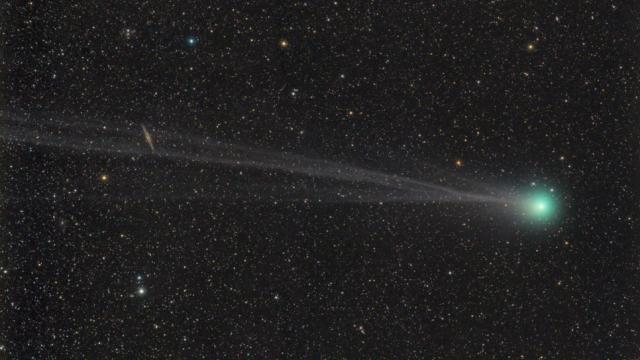With the historic Rosetta mission now firmly in the rear view mirror, the European Space Agency has set its sights on a different kind of comet, that is, a comet that’s never visited the inner reaches of the solar system. Called Comet Interceptor, the mission will include a mothership and two ‘daughter’ spacecraft.
A press release issued today by the ESA describes the new Comet Interceptor mission, which is scheduled for launch in 2028. The mission is unique in that it’ll be our first encounter with a comet that’s making its first trip into the inner solar system.
Such objects, dubbed “pristine comets” or “dynamically new comets” feature unperturbed surfaces and structure, having avoided a close encounter with the Sun for billions of years. Accordingly, these comets are like a snapshot back into time, revealing the conditions of the nascent solar system.
Comet Interceptor will involve scientists and engineers from University College London, Edinburgh University, NASA, JAXA, among other contributors. The project will be led by Geraint Jones who’s at UCL’s Mullard Space Science Laboratory. Now that the mission has been given the go-ahead, the various teams will work together to iron out the details.
No specific comet has been chosen, nor is it likely that one will be selected prior to launch. Once in space, the Comet Interceptor spacecraft will venture out to about 1.5 million kilometres from Earth and assume a holding position.
After a suitable comet is detected, the spacecraft will be dispatched for an intercept mission. Mission planners will either select a pristine comet, or an incoming interstellar visitor similar to ‘Oumuamua—the cigar-shaped comet or asteroid or whatever the hell it was that unexpectedly zoomed through our neighbourhood in 2017.
Comet Interceptor’s holding period in space shouldn’t last too long, with mission planners expecting a rendezvous within the first five years of the mission, according to the ESA.
A suitable instrument to detect an incoming object exists in the Pan-STARRS ground telescope in Hawaii. Such objects are often detected about a month or a few years prior to entering into the inner solar system, which isn’t enough time to design and deploy a rendezvous mission. Comet Interceptor solves this problem rather elegantly.
The main spacecraft, or mothership, will observe the comet from a distance, but it will also deploy a pair of daughter spacecraft, which will travel toward the comet to make observations at close range. The probes should be able to detect small surface features, characterise the shape of the object, and analyse the gasses streaming off of the comet.
Together, the three spacecraft will make measurements from multiple vantage points, allowing for an unprecedented 3D view of the object—or objects. Though rare, some comets consist of multiple pieces, as evidenced by the recent discovery of a binary system bearing the characteristics of a comet.
Instruments aboard the three Comet Interceptor spacecraft will collect information about the object’s dust, plasma, mass, chemical composition, and other valuable scientific data. Indeed, the sight of a pristine comet entering into the inner solar system should be quite a treat.
Having never seen the Sun from up close, and with its “unprocessed” surface, the comet will likely put on quite a display. Cosmic rays from the Sun will interact with its volatile surface, kicking up dust, gas, and ice. Accordingly, there’s a very good chance the comet will produce a coma—a gassy envelope surrounding the comet—and long tail.
A suitable object for this mission would likely come from the Kuiper Belt or more distant Oort cloud, both of which host some of the solar system’s most ancient objects. Every once in a while, a comet or asteroid gets jostled from these outer areas, causing it to enter into a trajectory that takes it close to the Sun.
This project was selected as part of the ESA’s new fast-class mission, with “fast” referencing the speed of deployment. Fast-class missions should take no longer than eight years to roll out.
Additionally, spacecraft can’t be any heavier than 1,000 kilograms (2,200 pounds) and be capable of sharing rocket space with a medium-sized mission. The booster strength will propel both missions past Low Earth Orbit (LEO) and into the Sun-Earth Lagrange point, or L2, which is 1.5 million kilometers behind the Earth from the perspective of the Sun.
In this case, the accompanying medium-sized mission is anticipated to be the ESA’s Atmospheric Remote-sensing Infrared Exoplanet Large-survey (ARIEL) spacecraft, which will survey the atmosphere of distant exoplanets.
This mission will be the ESA’s third encounter with a comet, the prior two being the Giotto and Rosetta missions which visited Halley’s Comet in 1986 and comet 67P/Churyumov-Gerasimenko from 2014 to 2016, respectively.
Both of these comets are short-period comets featuring orbital periods less than 200 years, and have visited the inner solar system numerous times.
